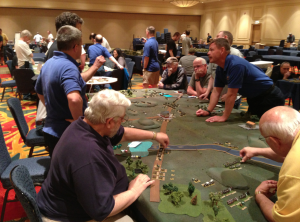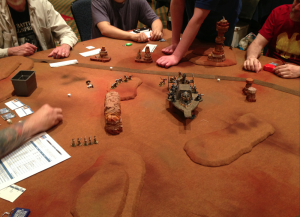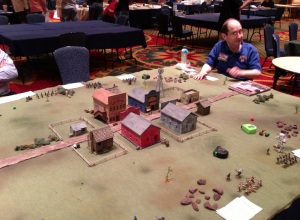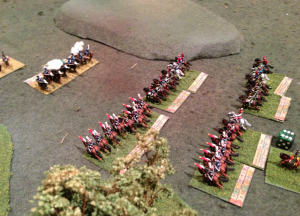Cigar Box Battle: Buck, for those who don’t know you, could you tell us a little about yourself?
Buck: I’ve been war gaming since about the seventh grade when I picked up a copy of the republished Little Wars and began using them in my basement. In high school I moved on to Airfix Figures and Rally ‘Round the Flag, which remains for me a very solid, enjoyable set of rules for the American Civil War. Through high school and college, I also played a lot of SPI and Avalon Hill board games. I caught the game design bug early, publishing my first game, Beer and Pretzels Urban Combat, as a senior. If you check out www.bucksurdu.com and browse around, you can see many of the other rules I’ve designed and published. Some are decent and playable, like Fire Team Vietnam, and others are really innovative and exciting, like Quick and the Dead (for PT boat actions). Most are still available if your readers find anything of interest. All are largely overshadowed by splashier sets of rules with a team of bloggers to hawk them.

Buck Surdu and crew did a great job running this 10mm Prussian vs French Napoleonic battle. The HAWKs ran a bunch of games at the con. Thanks guys!
Chris Palmer and I began collaborating on game design with the publication of Blood and Swash / Thunder and Plunder for pirate actions. Blood and Swash remains a simple, flexible, entertaining set of skirmish rules if you don’t want any command and control or morale, just fisticuffs and musketry. We’ve also use Blood and Swash for games ranging from ancient Rome to WWII.
Thunder and Plunder grew into G.A.S.L.I.G.H.T., Glorious Adventures in Science, Loosely Involving Generally Historical Times, which after 12 years remains the set of rules to which others compare themselves for Victorian science fiction. Of all my design efforts, GASLIGHT has been the only real commercial success. After publishing several supplements, including one for Pulp gaming (To Be Continues… by GASLIGHT) and one for larger battles (Battles by GASLIGHT), we combined them all into a single volume, the GASLIGHT Compendium, along with additional, new content which can be ordered from On Military Matters, Brigade Games, and Old Glory, among others, or as a pdf download from RPGNow. There is also a free quick-start guide for GASLIGHT available at www.gaslightrules.com.
Cigar Box Battle: Tell us about the Look, Sarge, No Charts family of rules.
Buck: We added Dave Wood to the collaboration team when I was working on designing a set of rules for WWII battalion- and brigade-level combat. I had played all of the popular WWII sets of rules for that period (and many of the skirmish sets as well), but none of them felt right to me. I wanted a set of rules that MOVED, that felt like maneuver warfare, in which infantry weren’t just speed bumps for people who just wanted to play with tanks, and where reconnaissance mattered. It took me six years to write Look, Sarge, No Charts WWII. Along the way, I completed and threw away two other designs.
(I think a game designer needs to be prepared to throw away sets of rules and start over. I wrote and threw away two sets of rules for WWII skirmishing before settling on Beer and Pretzels Skirmish.)
One of the things we struggled with was the activation mechanism. It was Dave who had the epiphany to adapt the “double random” activation sequence we wrote for Battles by GASLIGHT for WWII. This system gives you the unpredictability of card-based activation without having ten players watch one person doing something. I was looking for something really innovative for spotting, and eventually hit upon the use of the spotting dice after playing Memoir 44. Richard Borg uses special dice for combat results, and it occurred to me that we could modify that concept for spotting. After an hour or so of running probabilities using a binomial distribution in Excel, I confirmed that the math was just about right. We didn’t set out to write a set of rules without chart cards, but along the way it dawned on me that we were so close that we should give it a try. That’s when we thought about putting the important information for units on the base labels, like an old SPI or Avalon Hill game. The last thing that was left was morale. A little more running of numbers and the morale dice were born.
Now some people have a strong, visceral reaction to the base labels. To some extent they are right that the labels have an impact on the aesthetics of the table. I argue that the aesthetics are harmed more by large yellow and pink 8.5”x11” cards or foldout flow charts than by the base labels, especially when printed on neutral-colored paper. Still, we also offer rosters as free downloads that people can use in lieu of the base labels if they prefer. We think that the base labels really speed play, because all the information you need is where you are already looking and doesn’t have to be looked up on another chart.
Of all my game designs, both solo and with collaborators, the Look, Sarge family is the one I’m most proud of – and most disappointed with (the lack of) public acceptance. I’ve been doing this game design thing for a long time, both as a hobby and for a while as part of my military duties. There are a number of really innovative features to the rules: activation, firing, morale, and spotting. But it’s not just a bag of interesting mechanics; they work together to make a streamlined, elegant system that is easy for novices to pick up and interesting enough to keep old hands happy. Yet, it just hasn’t gotten much attention. Part of it is likely to title, which many don’t take seriously. (I was advised against using that title, but went ahead with it anyway.) Part is also the likely, visceral reaction to the base labels and the perceived (false) threat of having to rebase your figures to use the rules.
Regardless, we decided to adapt the basic mechanics of Look, Sarge, No Charts: WWII for the American Civil War. I thought it would be an easy task; however, it took us a lot of play testing and two years. While the basic mechanics remained the same, there were a number of enhancements and modifications to make it feel right. There was one day during play testing when I had this “a ha” moment watching some guys play the game when I realized how much the table looked just like pictures and paintings of real civil war battles. It just FELT right. In its way, A Union So Tested: Look, Sarge, No Charts: American Civil War is an even better game than its WWII predecessor. We’re really proud of these rules. We’ve also been asked to support some officer professional development events for a nearby signal battalion where we’ve run games with as many as 50 non-gamer players. We’ve been gratified by the fact that these non-gamers quickly grasp the rules. Many have even formed their own gaming club!
Cigar Box Battle: Tell us a little about your most recent publications.
Buck: To be honest, I was only mildly interested in the American Civil War version of the rules. For me it was an intermediate step to my first love: the Napoleonic Wars. Again, I thought that moving from ACW to Napoleonic Wars would be relatively straightforward. I was wrong. I also knew that to some extent I was pushing a rope up a hill, since almost everyone in my gaming group hates Napoleonic gaming. Like many in the hobby, they had the perception that Napoleonic games must be slow, pedantic, and painful affairs managed by rules lawyers, whiners, debaters, and Napoleonic trivialists who would rather try to impress you with their arcane knowledge of the unimportant than play the game. When someone brings a Napoleonic game to a club night, it’s generally referred to as “punitive Napoleonics.” I took it as a challenge to write a set of Napoleonic rules that would satisfy old Napoleonic grognards as well as be accessible to newcomers and those who have sworn off the period.
The design of Fate of Battle: Look, Sarge, No Charts: Napoleonic Wars was made difficult by the realization that Napoleonic gamers would expect the explicit representation of formations and skirmishers. Adding formations seemed simple, but it caused cascading ripples through the rules that took two years to smooth back down. Dave sets himself up as the “detail guy,” arguing that one aspect or another is critical to represent. My role is the synthesizer, streamliner, and “degunker.” I determine that something is so small of a factor that it is represented by the die roll or find a way to incorporate it without breaking the system or gunking up the rules. Napoleonic grognards love gunk, but I know that is exactly what turns off many gamers to the period. In the end, over several long runs around Baltimore Washington Airport, we worked out most of the ideas.
So this leads me to a slight aside. Game design starts with statistical analysis, but in the end it is almost like sculpting. There’s an old joke about how easy it is to carve a duck decoy. You start with a block of wood and carve away everything that’s not a duck. Once I set the level of abstraction, in this case I wanted players to command Napoleonic divisions, you have to remain consistent with that level of abstractions. Things that that commander would trust to subordinates should not be player decisions. In a WWII game, a battalion command doesn’t decide which round to shove into the breach of a tank, a sergeant or lieutenant does that; so the player should not concern himself with that either. The underlying mechanics have to represent that folks at lower echelons are acting in a generally rational manner but allow enough variation to reflect that sometimes they make mistakes – all outside the control of the battalion commander.
In most Napoleonic games, including the previous two sets of rules I wrote and published, skirmishers tend to be demigods. They move fast, have loose command and control, are hard to hit, and sometimes even fire better than infantry in line. To us, this didn’t represent the real role and battlefield impact of skirmishers, which wasn’t to inflict lots of casualties, but instead to cause disruption. We wanted to explicitly represent skirmishers in our game but not have them inflict lots of casualties and not have division commanders managing the placement of skirmisher companies with micrometers and protractors. We decided on an inter-turn phase, called the skirmish fight, in which opposing skirmish screens fight to remain deployed or withdraw. The winner of the skirmish fight then has an advantage in the upcoming turn in firing, rolling to close, and rolling to stand. This is a much better representation of skirmishers than we had seen in other games, and it is resolved quickly – without the use of additional charts.
Again, we are extremely proud of these rules. We have in fact developed a Napoleonic game that the folks in our club will play willingly and enjoy. Despite a long review in Miniature Wargames that I think was meant to be humorous but just came across as negative, those who have tried the game in conventions – both newcomers to the period and old hands — have seemed to be happy with the experience. They’ve been on the market since October and can be purchased as a .pdf download from RPGNow or purchased in book form from On Military Matters, Old Glory, and Brigade Games. We recently ran several Napoleonic games at Nashcon, where the rules seem to have been well received. Several gamers came back for more than one game!
Cigar Box Battle: What’s in the future for you and your collaborators?
Buck: We currently have Bear Yourselves Valiantly: Look, Sarge, No Charts: Fantasy, Ancients, and Mediaeval in active development. Most of our play testing has been focuses on fantasy and the Roman era, but we’re beginning to test in the 100 Years War era as well. By Christmas I hope that development is mature enough that I can begin to write the book, which generally takes six months for writing, editing, photography, layout, and printing. Many who have tried the game have said it’s the most enjoyable ancient game they’ve every played.
While there is a glut of WWII, modern, and SciFi skirmish rules on the market, I think the ultimate set that will satisfy both newbies and experienced gamers is yet to be written. As a solo effort I’ve been toying with two very different sets of ideas in parallel for about a year, but little is ready to see the light of day just yet. One idea takes some of the good ideas from Beer and Pretzels Skirmish and combined them with new concepts from Look, Sarge, No Charts. The other is more old school. We’ll see whether either of these sees the light of day.

Mars by G.A.S.L.I.G.H.T – A great looking Victorian Sci-Fi game run by the HAWKs. Thanks for coming to the convention guys! It was great seeing my friend Buck Surdu again!
Dave, Chris, and I have been talking about two more additions to the Look, Sarge, No Charts family of rules. One is for really large Victorian Science Fiction battles that are outside the scope of even Battles by G.A.S.L.I.G.H.T. With the recent release of titles like When the Navy Walked and All Quiet on the Martian Front, the market probably won’t bear another set of large-scale VSF rules right now. The other idea is for near future ground combat rules.
We want these rules to be very different from WWII with lasers. To be interesting, we think near future rules would need to incorporate aspects of smart weapon, unmanned vehicles, and remote sensors. This is difficult to do on a tabletop. During long runs I’ve been toying with concepts for an inter-turn phase for cyber warfare, in which opposing cyber forces fight a battle within a battle for control of their own and their enemy’s command and control and sensor networks. The results of this inter-turn phase would impact the use of remote sensors, activation of units, use of smart weapons, etc. This would be very unique in a miniatures game and would give this set of rules a very different feel from the others in the family.
We also have a partially developed set of rules, called Wizard War, in which players control just one or two wizards in a duel-like setting. Think of the fight in the library in Harry Potter. The system is based on Quick and the Dead, which is in turn based on Kurt Schlegel’s unpublished Fire at Will. There are no turns; players play action cards to move and cast spells as fast as they can in an asynchronous manner, so those guys who like to wait until it’s their turn to begin to think about what they want to do, don’t do well in this game. Wizard War was pushed to the back burner to get Fate of Battle out the door. There may be interest in reviving it.
Personally, I’ve always wanted to game the American War of Independence but have been consistently sidetracked by other projects. I was really excited by the announced release of painted AWI 10mm figures from Gordon and Hague, but the company has changed their plans. I was excited about a Look, Sarge variant for the AWI period for two players to fight a large battle on a kitchen table. I think the ultimate AWI rules are yet to be written; although, Regimental Fire and Fury is quite good. I read an article recently in Miniature Wargames written by the late Wally Simon that gave me a lot of food for thought about morale and how to make it the central idea of an 18th century game. AWI with Old Glory 28mm figures is likely to be my “project after next” for some time to come.
I also think there is a crying need for an American wargaming magazine that is run like a business, not a hobby. When I retire, I’d like to look into working with a handful of collaborators to get something like this started.



One response to “An Interview with Buck Surdu, Game Designer”
Te agradan las jóvenes rodadas en videos porno, pues no teque perder
esta petarda que si sabe follar como toda una puta.